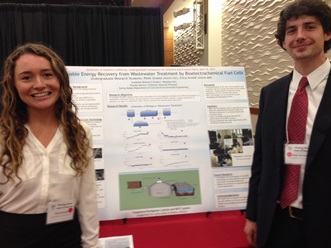
Erica Arnold & Peter Grasso – Sustainable Energy Recovery from Wastewater Treatment by Bioelectroche
April 22, 2014 4:46 pmProject Summary:
BEFCs have the ability to reduce costs for wastewater treatment by generating electricity through the treatment of
wastewater itself. BEFC Batch studies were performed to determine which bacterial community within a wastewater
treatment facility would optimize energy generation. Sustainable wastewater treatment approaches for developing nations
were also examined.
Main Issue:
This study addresses the functions, benefits, and applications of BEFCs with an emphasis on their applications in sustainable
treatment of wastewater. The power generation potential of BEFCs with varying consortiums of bacteria was studied by
inoculating bacteria into the BEFC from different parts of the wastewater treatment facility. This was done to help identify
the best source within the facility for energy generation.
Learning Outcomes:
Through our research we learned a number of skills and analytical techniques pertaining to the assembly and maintenance
of dual chambered BEFCs as well as bacteria acclimation and inoculation techniques. We also investigated the optimum
locations within the wastewater treatment process for energy generation. We have developed better interpersonal and
leadership skills through working as a team.
Student Contribution:
Both undergraduate students contributed equally to the research, performing all of the necessary tasks including BEFC
electrode and membrane preparation, BEFC assembly and monitoring the energy production on a daily basis.
Undergraduate researchers consulted faculty advisor, Professor Pirbazari, weekly and graduate student, Woonhoe Kim, daily
but were responsible for their own research.
Abstract:
Wastewater treatment is currently an energy intensive process. Energy costs are forecasted to increase in the future in
conjunction with a global population increase and rising energy demands. BEFCs can be used to reduce the net energy
requirements of wastewater treatment systems by using the wastewater as a carbon source for the generation of electricity.
BEFCs exploit the natural behavior of bacteria to break down organic matter and release chemical energy. The bacterial
community composition of BEFCs can substantially impact the system’s capacity to generate energy. Much of current
research focuses on culturing specific bacteria strains to generate energy. This approach while helpful for a laboratory
setting is impractical in a treatment facility. In several cases research has shown that a mixed consortium of bacteria can
generate ten times as much energy as a single strain of bacteria. In a wastewater treatment facility different bacterial
communities exist within each step of the treatment process.
This study attempts to determine what location within a treatment plant would contain the most effective microbial
population for energy generation. Using bacterial communities from within treatment facility ensures bacterial population
that is not only readily available but is also already acclimated to the composition of influent wastewater. This study also
addressed the applicability of BEFC technologies to rural parts of developing nations. Combining this technology with
another wastewater treatment approach such as a biodigester latrine could help generate multiple sources of renewable
energy for rural and developing communities.
Categorised in:
This post was written by Admin3
